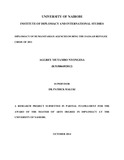| dc.description.abstract | Humanitarian aid has three goals: The drive to lessen suffering, save life and above all maintain
human dignity required of people caught up in the situation. But each disaster presents
humanitarian workers with different challenges. This study sought to find out humanitarian
agencies used diplomacy to meet these goals during the Dadaab refugee crisis of 2011 in the face
of challenges and sometimes opposition from the Kenyan government. Based on the tenets of
constructivism, the study demonstrates that humanitarian agencies work based on identities
created by norms. The research was based on interviews with field workers of humanitarian
agencies and officials of Kenya government departments, as well as a review of reports on the
crisis. The findings indicate that relief agencies grappled with an influx of refugees who burst the
camp, security challenges, fundraising as well as accessing the camp itself and despite them
having the goals of serving refugees in need of emergency assistance for shelter, food and
nutrition, water and hygiene and health, they were met with a Kenyan government with different
ideas about the camp. To aid agencies, the existence of the camp demonstrated Kenya’s
adherence to international norms concerning refugees. To Kenya, it depicted an unnecessary
burden. Humanitarian agencies pushed Kenya to expand the camp through humanitarian
diplomacy. The study shows that humanitarian diplomacy differs from mainstream diplomacy of
states because emergency aid agencies do not confront the government in discussions, rather,
they use other parties as they focus on their core business of delivering relief. At Dadaab,
international humanitarian agencies often used the media, collaborated with local aid
organisations, used influential personalities and lobbied donors to woe decision makers in
Kenya. This research finds that although states are the main players in the international
humanitarian politics, humanitarian agencies are increasingly asserting their power and
influence. There is no likelihood of crises such as that of Dadaab in 2011 coming to an end. That
means that humanitarian agencies and governments will continue to interact. This means that the
role of humanitarian agencies is very important in today’s conduct of international relations.
Perhaps we need to draft a treaty that would grant diplomatic privileges given to humanitarian
workers to help them do their work, just like state diplomats have. | en_US |

